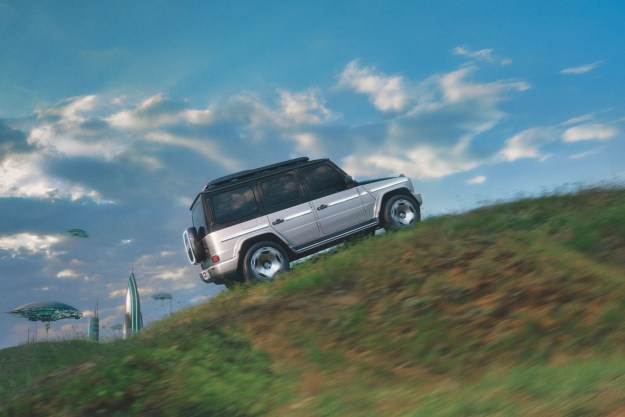A Bugatti is more of a work of art with four wheels than a car. And new models don’t come around very often. When one is introduced, the entire auto industry sits up and takes notice.
Introduced at the Geneva show, the Chiron receives an 8.0-liter W16 engine that uses four turbochargers to generate a jaw-dropping 1,500 horsepower and 1,180 pound-feet of torque from 2,000 all the way up to 6,000 rpm. That’s enough power to fling the carbon fiber-bodied coupe from zero to 62 mph in 2.5 seconds, from zero to 124 mph in less than 6.5 seconds, and from zero to 186 mph in 13.5 seconds. Top speed is electronically limited to 261 mph, though insiders suggest the Chiron maxes out at over 290 mph when the limiter is turned off.
Digital Trends sat down with Willi Netuschil, the head of Bugatti’s engineering department, to find out what makes the Chiron tick.
Digital Trends: Saying that the Chiron has big shoes to fill is an understatement. What was the most challenging aspect of designing it?
Willi Netuschil: The most challenging aspect was clearly to combine that much power and that much torque in a package that the driver can really control. As you can imagine, putting all that power to the ground is difficult, even with four-wheel drive. We looked into a lot of different solutions, and we ultimately developed a special two-stage turbocharging system that delivers a very straight power curve. In other words, it’s easy to control the Chiron.
How much of the engine is new?
Keep in mind the base engine was developed to generate 1,000 horsepower. We increased that figure to 1,200, and now we’ve just bumped it up again by 25 percent, so we re-worked it entirely for the sake of durability and efficiency.
We didn’t stop at the engine, either. Notably, the air intake system is very innovative and completely new. It’s a one-piece component made out of carbon fiber in order to reduce back pressure and to shed as much weight as possible. We did the same with the exhaust system, which is made out of titanium.
The transmission is a seven-speed, dual-clutch unit that has also been redesigned. The W16 generates a lot of torque over a very wide band so the durability requirements are much higher.
Why did you choose 1,500 horsepower?
We spent a lot of time discussing how much power we should give the Chiron. We knew we had to set a new high speed record, and it was clear from the beginning that we needed 1,500 horsepower. With eight liters of displacement we achieved more or less 200 horsepower per liter, which is amazing.
How do you cool 16 cylinders?
You can’t compare the Chiron with anything else on the road.
Speaking of brakes, tell us a little bit about what brings the Chiron to a stop.
We had to really improve the braking system because the Chiron is so much faster. We’ve patented a completely new system. It has new calipers with titanium pistons, and a special cooling design with three channels that bring cold air through the discs. We also developed a shield that covers the discs to ensure that the heat generated while braking doesn’t go directly into the rims, because that would cause problems with the tires. Air curtains bring hot air away from the brake system while simultaneously keeping it out of the rim.
You used carbon fiber to keep weight in check, right?
Up front we have very short frames made out of aluminum, we need those for safety reasons. They’re about 21 inches long, and we installed carbon fiber crash elements inside of them. Then we have the carbon fiber monocoque, and then we’ve got the complete rear frame which adds stiffness. Finally, we have very short aluminum frames at the rear end of the car, also for safety reasons.
This packaging solution allowed us to achieve the best level of stiffness in the industry. We’ve reached nearly 37,000 pound-feet of torque per degree, which is really on par with a LMP1 car.
Did you ask Veyron owners to give you feedback when you were designing the Chiron?
We met with a lot of customers, and they told us they wanted a car with a relatively comfortable ride, that’s easy to handle, that provides very quick acceleration, and a high top speed. They also said they want to feel safe inside the car. Finally, buyers expect a luxurious interior and, broadly speaking, a very exclusive car. You can’t compare the Chiron with anything else on the road.
Are you worried about competition from companies like Koenigsegg? The Regera makes 1,500 horsepower, too.
If you select competitors by looking at performance data then you will find a few cars that come close to the Chiron, but I’m sure we’ll top them because we combine performance with four-wheel drive. Our car has more traction under heavy acceleration than other cars at this level. Also, most of the other cars are, in a way, race cars. Our philosophy is different: you can enjoy speed and acceleration while sitting in a relatively quiet cabin with excellent ergonomics. You can drive the Chiron long distances.
We’re not out to develop race cars. Most of our customers own a lot of exclusive, high-end cars so if they’ve generally got at least one that they can take to the track if they want to. If anything, Bugatti owners drive to a track, go out for a lap or two, and drive home.








